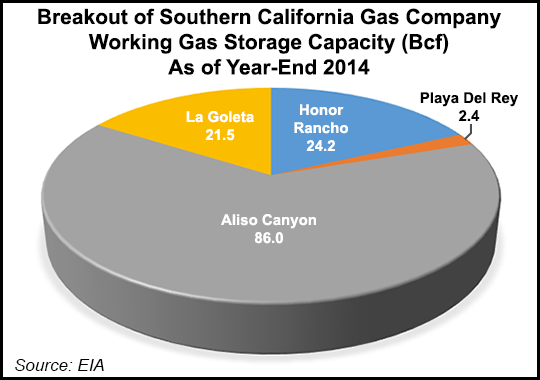Markets | NGI All News Access | NGI The Weekly Gas Market Report
SoCalGas Leak Emissions Down 60%, Tests Indicate
While the target date for plugging the leak is still two months off, emissions have dropped 60% at the natural gas well storage site at Southern California Gas Co.’s Aliso Canyon underground field near Los Angeles, according to estimates by state regulators that were issued on Tuesday.

The beleaguered Sempra Energy gas utility touted the most recent preliminary emissions estimates from the California Air Resources Board (CARB), which is maintaining air monitoring sites with regional air pollution regulators in the Porter Ranch residential community that borders the south side of the storage field.
Readings as of last Friday showed 23,400 kilograms of methane (kgm)/hour, a steady drop over a five-week period from the peak reading of 58,000 kgm/hour on Nov. 28. The estimated methane leaked during the recent eight-day period was 4.49 million kgm, and the cumulative total leakage since the Oct. 23 discovery is 4.4 Bcf, up by 200 MMcf since Dec. 23.
A SoCalGas spokesperson said the latest CARB figures also represent a 20% reduction in the leaking gas since the Dec. 23 readings.
CARB’s periodic estimates are based on data collected during flyovers using sensitive methane monitoring equipment, providing an estimated emission rate at the time the flights are conducted. SoCalGas and CARB officials reiterated that a more accurate estimate of the actual emissions will be made once the leak is stopped.
In contrast to environmental and residents’ groups that have portrayed the incident as possibly the worst natural gas leak ever, CARB’s latest calculation includes an estimate of the greenhouse gas (GHG) emissions in millions of metric tons (mmt) in carbon dioxide equivalents (CO2e) that have been released since the leak’s discovery, placing the cumulative total last Friday at 1.9 mmt, which represents less than one-half of 1% (0.4%) of the state’s total annual GHG emissions.
SoCalGas, the nation’s largest gas-only utility, seized on the state statistics to make its case that it is having some success in mitigating the environmental impact from the actual amounts of gas being released from the stubborn leak.
CARB said periodic measurements continue to be carried out by Scientific Aviation, using small planes equipped with sophisticated detection/measurement equipment.
“These periodic measurements provide an emission rate at the time the flights are conducted and may vary considerably; they do, however, provide a sense of what is happening with the leak,” CARB said in a website posting (www.arb.ca.gov/).
SoCalGas reiterated what it has said in recent weeks about working with the California Public Utilities Commission to withdraw gas from Aliso Canyon near its maximum 1.5 Bcf/d capability to reduce the rate of the leaking gas.
Using percentages, the utility estimated that the Aliso storage volumes were about 77 Bcf before the leak and as of last Sunday were in the low 30-33 Bcf range.
The utility’s well-specific gas capture system is now ready, but SoCalGas officials indicated it won’t be deployed until “site-specific safety conditions allow.”
© 2024 Natural Gas Intelligence. All rights reserved.
ISSN © 1532-1231 | ISSN © 2577-9877 | ISSN © 1532-1266 |
